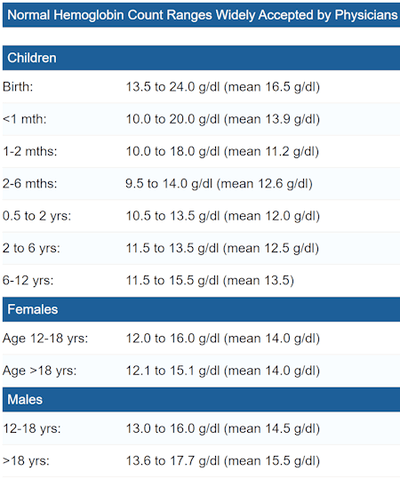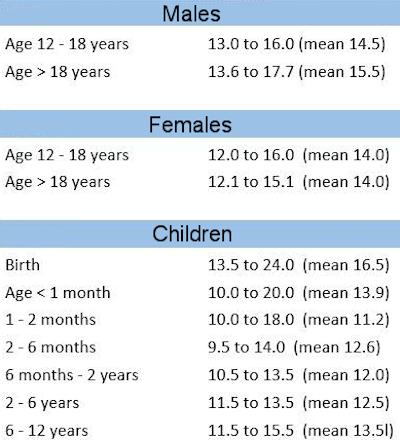Hemoglobin Level Chart and Body Iron Information
Ian C. Langtree - Writer/Editor for Disabled World (DW)
Published: 2015/07/20 - Updated: 2025/04/08
Publication Type: Charts, Graphs, Tables
Category Topic: Medical Calculators and Charts - Academic Publications
Page Content: Synopsis - Introduction - Main - Insights, Updates
Synopsis: These charts provides comprehensive information on hemoglobin levels and body iron, offering valuable insights into the role of hemoglobin in oxygen transport and overall health. It includes detailed charts of normal hemoglobin ranges across various age groups and genders, making it a practical reference for healthcare professionals and individuals managing conditions such as anemia or polycythemia. Additionally, the article explains the causes and symptoms of abnormal hemoglobin levels and highlights dietary recommendations for iron-rich foods to support healthy hemoglobin levels. This information is particularly useful for seniors, individuals with disabilities, or those at risk of iron deficiency-related health issues, enabling informed decisions about nutrition and medical care - Disabled World (DW).
Introduction
Symptoms of Anemia Often Include:
- Fainting
- Pale skin
- Weakness
- Chest pain
- Palpitations
- Shortness of breath
- Restless legs syndrome
Main Content
Hemoglobin Level Chart
| Normal Hemoglobin Count Ranges Widely Accepted by Physicians | |
|---|---|
| Children | |
| Birth: | 13.5 to 24.0 g/dl (mean 16.5 g/dl) |
| <1 mth: | 10.0 to 20.0 g/dl (mean 13.9 g/dl) |
| 1-2 mths: | 10.0 to 18.0 g/dl (mean 11.2 g/dl) |
| 2-6 mths: | 9.5 to 14.0 g/dl (mean 12.6 g/dl) |
| 0.5 to 2 yrs: | 10.5 to 13.5 g/dl (mean 12.0 g/dl) |
| 2 to 6 yrs: | 11.5 to 13.5 g/dl (mean 12.5 g/dl) |
| 6-12 yrs: | 11.5 to 15.5 g/dl (mean 13.5) |
| Females | |
| Age 12-18 yrs: | 12.0 to 16.0 g/dl (mean 14.0 g/dl) |
| Age >18 yrs: | 12.1 to 15.1 g/dl (mean 14.0 g/dl) |
| Males | |
| 12-18 yrs: | 13.0 to 16.0 g/dl (mean 14.5 g/dl) |
| >18 yrs: | 13.6 to 17.7 g/dl (mean 15.5 g/dl) |
Low Hemoglobin Count
A slightly low hemoglobin count isn't always a sign of illness; it may be normal for some people. Women who are pregnant commonly have low hemoglobin counts. A low hemoglobin level count is generally defined as less than 13.5 grams of hemoglobin per deciliter (135 grams per liter) of blood for men and less than 12 grams per deciliter (120 grams per liter) for women. In children, the definition varies with age and sex. Diseases and conditions that cause your body to produce fewer red blood cells include:
- Cancer
- Cirrhosis
- Leukemia
- Lead poisoning
- Aplastic anemia
- Multiple myeloma
- Certain medications
- Iron deficiency anemia
- Chronic kidney disease
- Non-Hodgkin's lymphoma
- Vitamin deficiency anemia
- Myelodysplastic syndromes
- Hypothyroidism (under-active thyroid)
- Hodgkin's lymphoma (Hodgkin's disease)
- Blood Loss from Bleeding (Internal or External)
Iron Levels
Iron is a mineral that's essential for making healthy red blood cells and hemoglobin. Low iron levels can cause you to feel tired, and deficient iron levels may cause damage to organs. A low blood count can be caused by not eating enough iron-rich foods, donating blood too frequently, chronic illness, or other invisible causes. The daily requirement of iron can often be achieved by taking iron supplements. Ferrous sulfate 325 mg, taken orally once a day, and by eating foods high in iron. Foods high in vitamin C also are recommended because vitamin C helps your body absorb iron. Food with high iron levels includes:
- Bean Sprouts
- Beets
- Broccoli
- Brussel Sprouts
- Cabbage
- Chicken
- Corn
- Fish
- Green Beans
- Greens, all kinds
- Kale
- Lamb
- Lean beef
- Lima Beans
- Liver
- Mussels
- Pork
- Potatoes
- Shellfish
- Peas
- Tofu
- Tomatoes
- Turkey
- Veal
High Hemoglobin Level
High hemoglobin level is mainly due to low oxygen levels in the blood (hypoxia), present over a long period. Reasons for a high hemoglobin level include:
- Burns
- Dehydration
- Severe COPD
- Heavy smoking
- Polycythemia vera
- Excessive vomiting
- Living at a high altitude
- Extreme physical exercise
- Failure of the right side of the heart
- congenital disabilities of the heart, present at birth.
- Scarring or thickening of the lungs (pulmonary fibrosis) and other severe lung disorders
- Rare bone marrow diseases that lead to an abnormal increase in the number of blood cells (polycythemia vera)
Hemoglobin A1c Test
The hemoglobin A1c test, also called HbA1c, glycated hemoglobin test, or glycohemoglobin, is an important blood test that shows how well your diabetes is being controlled. Hemoglobin A1c provides an average of your blood sugar control over the past 2 to 3 months and is used along with home blood sugar monitoring to make adjustments in your diabetes medicines.
- For people without diabetes, the normal range for the hemoglobin. A1c test is between 4% and 5.6%.
- Hemoglobin A1c levels between 5.7% and 6.4% indicate an increased risk of diabetes.
- Levels of 6.5% or higher indicate diabetes.
The goal for people with diabetes is a hemoglobin A1c of less than 7%. The higher the hemoglobin A1c, the higher the risk of developing complications related to diabetes.
Hemoglobin Level Image Charts for Printing
Chart 1

Chart 2

Insights, Analysis, and Developments
Editorial Note: While often overlooked, understanding hemoglobin and iron levels is a critical part of managing overall health, particularly for vulnerable populations. This article cuts through the medical jargon to offer accessible and relevant insights that can make routine blood test results more meaningful to patients. In doing so, it helps bridge the gap between clinical data and everyday well-being - Disabled World (DW). Author Credentials: Ian is the founder and Editor-in-Chief of Disabled World, a leading resource for news and information on disability issues. With a global perspective shaped by years of travel and lived experience, Ian is a committed proponent of the Social Model of Disability-a transformative framework developed by disabled activists in the 1970s that emphasizes dismantling societal barriers rather than focusing solely on individual impairments. His work reflects a deep commitment to disability rights, accessibility, and social inclusion. To learn more about Ian's background, expertise, and accomplishments, visit his full biography.
Author Credentials: Ian is the founder and Editor-in-Chief of Disabled World, a leading resource for news and information on disability issues. With a global perspective shaped by years of travel and lived experience, Ian is a committed proponent of the Social Model of Disability-a transformative framework developed by disabled activists in the 1970s that emphasizes dismantling societal barriers rather than focusing solely on individual impairments. His work reflects a deep commitment to disability rights, accessibility, and social inclusion. To learn more about Ian's background, expertise, and accomplishments, visit his full biography.